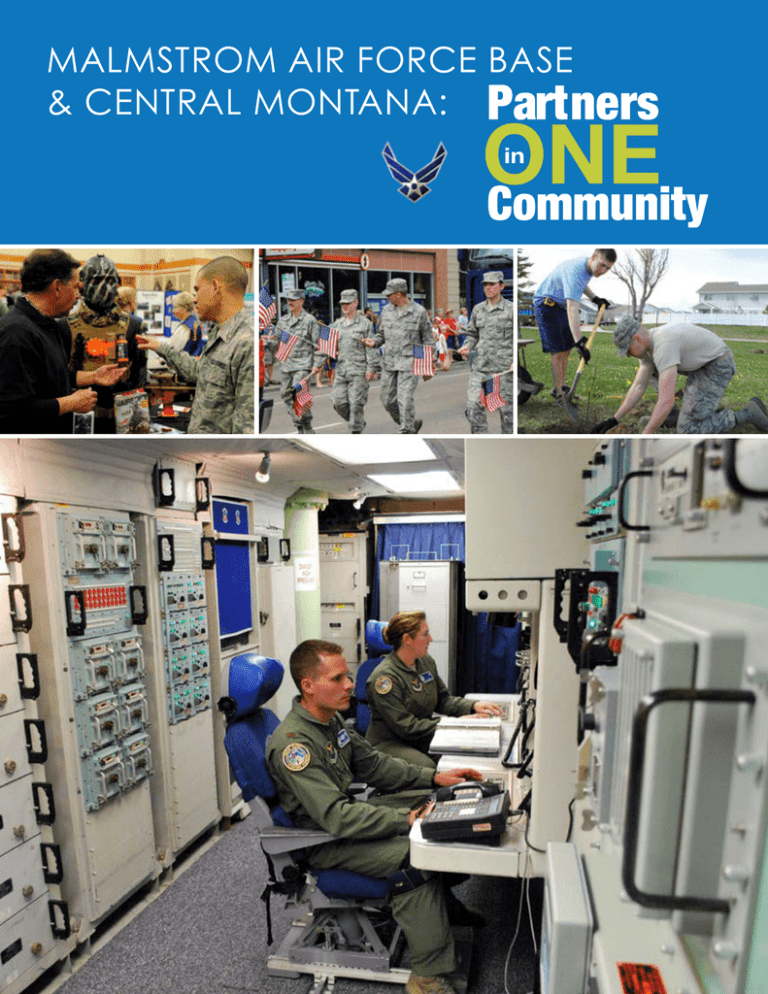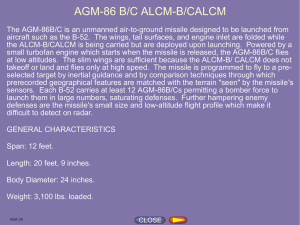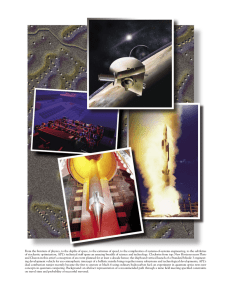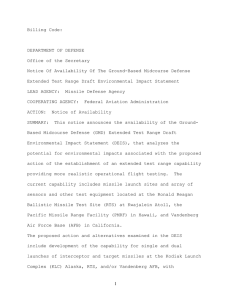Partners in One Community - Montana Defense Alliance
advertisement

MALMSTROM AIR FORCE BASE & CENTRAL MONTANA: MALMSTROM AIR FORCE BASE &CENTRAL MONTANA: PARTNERS IN ONE COMMUNITY Malmstrom Air Force Base’s (AFB) very existence traces back to strong community support. In 1939, the Great Falls Area Chamber of Commerce appealed to the two U.S. senators from Montana to consider developing a military base near Great Falls. Their advocacy resulted in the opening of Great Falls Army Air Base in 1942. In 1947, the base was assigned to the Air Force and renamed Great Falls Air Force Base. As the base’s mission and size evolved over the following decades, so too did the community outside its gates. Yet the community’s support of Malmstrom AFB has remained constant. “ This Partners in One Community brochure was developed as a part of a 2015 encroachment management study that considered areas of shared interest between the base, surrounding communities, and the missile field counties. This document highlights actions that the base and the community can take to enhance community sustainability while preserving the mission of Malmstrom AFB. Since its inception in 1939, Malmstrom Air Force Base has flourished with the enduring support of Great Falls and the counties of north central Montana. The base has evolved from a small Army base committed to helping our Allies sustain air support in World War II to a critical element of the nation’s strategic nuclear deterrence capability. That evolution and our continued mission success simply aren’t possible without the 4,000 Airmen that execute the mission every day and the mutually supportive relationship we have with the surrounding community. ” - John T. Wilcox, Colonel, USAF, Commander, 341st Missile Wing COMMUNITY Chief Master Sergeant Allen Markle, 341st Missile Security Forces Squadron security forces manager, receives a box of Girl Scout cookies from scouts from troops 3030, 3218, and 3500. Girl Scouts of Montana and Wyoming Council leaders encourage scouts to give back to the community every year. Located in Cascade County and bordered by Great Falls to the west, Malmstrom AFB recognizes and appreciates the enduring support of Great Falls and the seven counties that host the base and its missile facilities. Malmstrom AFB service members and their families volunteer hundreds of hours each year to numerous community outreach and support programs. Great Falls and the missile field counties have a history of supporting the military and continue to demonstrate that support in many ways. The efforts of the Great Falls Military Affairs Committee and local community organizations earned them the Zachary and Elizabeth Fisher Distinguished Humanitarian Service Award in 2001. This national award recognizes the contributions of individuals and organizations to the support and welfare of members of the United States Armed Forces and their families. MISSION Malmstrom AFB, home of the 341st Missile Wing (341 MW), supports national security and strategic deterrence by sustaining nuclear force capabilities and readiness. The 341 MW, made up of more than 4,100 people, including approximately 3,300 active-duty and 800 civilian personnel, is one of three Air Force wings responsible for maintaining and operating Minuteman III intercontinental ballistic missiles. The 341 MW staff and five groups carry out this mission by operating missile facilities distributed across Malmstrom AFB’s vast missile field. These specially trained Airmen provide security and maintenance for facilities and equipment on the base and throughout the missile field. Their essential day-to-day mission support activities keep the largest intercontinental ballistic missile complex in the world running at its best. ECONOMY ECONOMIC IMPACT Malmstrom AFB contributes more than $360 million Indirect Annual to the local Jobs Expenditures economy each 18% 23% year. The military payroll of the more Federal & than 3,300 Air Other Civilian Force personnel Payroll 12% assigned to the Military Payroll 47% base, combined with the salaries of the approximately 800 civilian Total Estimated Annual Economic and contractor Impact: $367.39 Million employees, injects an estimated Source: Malmstrom AFB Economic Impact, 2014 $215,731,880 into the economy. Additionally, federal funding contributes to the maintenance of more than 500 miles of access roads across the missile field. These access roads often support energy and community development independent of their use by the base, further contributing to quality of life, economic growth, and expansion of sustainable energy throughout the region. ENVIRONMENT The Malmstrom AFB missile field, which comprises more than 13,800 square miles, overlaps the existing habitat range of species of concern, including the greater sage-grouse and the Canada lynx. Sage brush and prairie pothole ecoregions throughout the missile field provide habitat to a variety of species and contribute valuable ecosystem services to the region. The Missouri River, a primary source of drinking water and major recreational amenity, flows just north of the base and through the missile field. The base’s natural resources personnel have dedicated significant manpower and resources to environmental stewardship and cooperative endeavors to protect species and habitat found in the region. 1 MALMSTROM AFB AND THE COMMUNITY COMMUNITY COLLABORATION Base personnel and their families enjoy all that the region has to offer in business and recreational opportunities. They also volunteer with numerous community organizations. The community says “thank you” by making Malmstrom AFB personnel feel welcome, and through groups like the Great Falls Military Affairs Committee within the city’s Chamber of Commerce. The Military Affairs Committee and similar community organizations throughout the region promote support for the military throughout the year by hosting appreciation events, luncheons, and golf outings, among other supportive endeavors. Volunteers help build a fence at the edge of the parking lot at Pow Wow Park as one of Malmstrom AFB’s projects in support of National Public Lands Day. GIANT SPRINGS Just north of Malmstrom AFB lies a historic natural gem, Giant Springs State Park. Lewis and Clark documented Giant Springs in 1805. Today it is recognized as one of the largest freshwater springs in the country. More than 250,000 people visit the springs each year to enjoy the natural features, explore the fish hatchery, and watch the wide variety of bird species in the area. The spring discharges nearly 156 million gallons of water into the Missouri River daily. Benton Lake Members of the Great Falls Area Chamber of Commerce Military Affairs Committee cook the food served during the Montana Air National Guard Family Day picnic. Giant Springs – 87 Great Falls, Montana photo used under creative commons license. Photo by Tim Evanson LEWIS AND CLARK NATIONAL FOREST Stretching across 13 counties and portions of 7 mountain ranges, the Lewis and Clark National Forest plays a role in the mission of Malmstrom AFB. Some missile facilities sit at the edge of, or just inside, the forest, and search-and-rescue training is conducted in the vicinity of forest lands. Visitors come from across the country to enjoy the forest’s public recreation opportunities, which include hiking, horseback riding, camping, and skiing. Key 15 Malmstrom AFB Great Falls 87 Protected Land 80 Missouri River Montana Governor Steve Bullock (left) cuts a ribbon after a sign representing Malmstrom AFB and Montana Air National Guard was mounted at the Great Falls International Airport. The sign was donated by the Montana Defense Alliance and the Military Affairs Committee of the Great Falls Area Chamber of Commerce. Giant Springs State Park 15 Belt 81 Malmstrom AFB Great Falls o Stanford Lewistown Lewis and Clark National Forest 89 Neihart 2 Great Falls International Airport Key Protected Land 87 Great Falls International Airport hosts the 120th Airlift Wing, a Montana Air National Guard unit, and it serves seven commercial airlines. Approximately 130 flights depart the airport daily. 87 3 THE MALMSTROM AFB MISSION Malmstrom AFB, then known as Great Falls Army Air Base, opened its gates in 1942 when the Army’s 7th Ferrying Group began using it to establish an air route between Great Falls and Fairbanks, Alaska, as part of the United States LendLease Program. Through this program, the United States provided essential support to Allies battling German forces in World War II. MISSILE FIELD Today, the mission of the 341st Missile Wing (341 MW) is “to defend America with safe, secure, effective nuclear forces and combat-ready Airmen.” To do this, the 341 MW maintains and operates the Minuteman III intercontinental ballistic missile and is part of Air Force Global Strike Command. The nuclear capabilities secured and operated at Malmstrom AFB by the 341 MW serve a key role in the nation’s broader strategic deterrence capability. 15 Upper Missouri River Breaks National Monument 87 Great Falls Planes are arranged in the final outfitting hangar and ready for the morning shift in June 1945. Malmstrom AFB 15 The Malmstrom AFB missile field comprises 165 facilities and support infrastructure dispersed throughout portions of seven counties in northcentral Montana. Maintenance crews, security forces, and missileers, who are specially trained Airmen tasked with operating and managing nuclear missile systems, navigate the missile field via helicopter and ground transportation. Maintenance crews inspect, repair, and sustain facilities, infrastructure, and LGM-30 Minuteman III intercontinental ballistic missile systems. Missiles are stored for deployment at 150 unmanned launch facilities throughout the missile field, while missileers stand constant “alert” at missile alert facility launch control centers located 40 to 60 feet underground. Security teams patrol the missile field from the air and on the ground 24 hours a day, 365 days a year. 87 287 MALMSTROM AFB MISSIONS The 341 MW consists of five groups, each with a specialized mission. The 341st Operations Group supports the readiness of missile launch facilities and missile alert facilities dispersed throughout the Malmstrom AFB missile field. The 341st Maintenance Group maintains the missiles and the communications systems required to operate them. Neither the operations group nor the maintenance group could carry out these missions without the dedicated support of the administration, construction, engineering, and other support provided by the 341st Mission Support Group and the medical care provided by the 341st Medical Group. The largest security forces group in the Air Force, the 314st Security Forces Group, keeps a watchful eye on the base and the missile complex. The 819th Rapid Engineer Deployable Heavy Operational Repair Squadron Engineer (RED HORSE) Squadron is a major mission partner at Malmstrom AFB. The squadron provides civil engineering capabilities in support of operations around the globe. During wartime, the 819th RED HORSE Squadron repairs damaged Air Force facilities and aircraft launch and recovery equipment. During peacetime, the unit trains for real-world operations and supports base construction efforts. The 40th Helicopter Squadron (40 HS) provides strategic security for the 341 MW with rapid-response helicopter airlift, aerial surveillance, convoy support, and emergency security forces responses. The squadron also supports the National Search and Rescue plan with more than 400 “saves” to its credit. In 2015, 40 HS was reorganized under the 582nd Helicopter Group at F.E. Warren AFB, in Cheyenne, Wyoming, but the unit’s day-to-day operations continue from Malmstrom AFB. 4 Lewis and Clark National Forest Lewistown Municipal Airport 89 Fort William Henry Harrison 90 Key Missile Field Missile Field County Boundary Protected Lands Refueling Airport REFUELING AIRPORTS Helicopters from the 40 HS routinely use local airports for training and refueling operations. Long distances between missile sites, some in excess of 150 miles from Malmstrom AFB, make civilian airfield refueling stops like Lewistown Municipal Airport essential to safe and efficient flight operations. 191 12 Camp Guernsey 350 miles DEFENSE ACCESS ROADS GROUND TRAINING AREAS Camp Guernsey, a 78,000-acre joint training center owned by the Wyoming Army National Guard, and Fort William Henry Harrison, an 8,500-acre training facility operated by the Montana Army National Guard, both support ground training requirements for the units assigned to Malmstrom AFB. 87 The Defense Access Road Program funds projects like reinforcing road banks with soil nail launcher technology, which is used to stabilize road embankments. The Defense Access Road Program provides the Department of Defense a means to fund road maintenance and repair on shared roadways that require more frequent or specialized maintenance due to use in military missions. Approximately 568 miles of roadway in the Malmstrom AFB missile field receive federal funding for maintenance and repair. Between 2009 and 2014, annual funding for Defense Access Roads maintenance in the Malmstrom AFB missile field averaged $4,790,000. 5 SHARED INTEREST, SHARED ACTION Malmstrom AFB strives to be a good neighbor by building and maintaining relationships with community stakeholders and collaborating on important issues. Through partnerships and collaborative efforts, the base and surrounding communities can continue to • • • • identify mutually beneficial opportunities, leverage resources, resolve common issues, and strengthen communication. This section highlights several areas of shared interest between Malmstrom AFB and the community. We welcome comments and questions—please see the contact information listed on the back of this publication. PARTNERS IN THE COMMUNITY Malmstrom AFB is one of several Air Force bases across the country that has participated in the Air Force Community Partnership program. The Air Force Community Partnership program is designed to leverage military and local community capabilities and resources to obtain value and benefit in support of the Air Force mission. This program explores cost-saving opportunities through innovative partnerships and shared services with local communities, government agencies, and businesses. It consists of a series of meetings between the community and the base that set the stage for long-term collaboration. Working groups established through the Air Force Community Partnership program are looking at partnership areas for Cascade County, Great Falls, and Malmstrom AFB, in areas such as a training co-op, parks and recreation, enhanced use land lease projects, and integrated public works. Working together in these and other areas could help reduce costs for essential training and services for both the base and the community. From left, Jane Weber, Cascade County commissioner; Michael Winters, mayor, Great Falls; Colonel Tom Wilcox, commander, 341st Missile Wing; and Colonel Pete Hronek, commander, 120th Airlift Wing; sign the Malmstrom Community Partnership Executive Leader Council charter. PARTNERS IN CONSERVATION Malmstrom AFB strives to be a good steward of the environment and seeks out opportunities to support Montana in sustaining its traditions of open space and open access while protecting the variety of species that make their home on the lands associated with the base. The great blue heron, grasshopper sparrow, and Swainson’s hawk are among the rare or potentially at risk species found on base property. The Malmstrom AFB missile field includes facilities and roadways in or close to habitats for several species that are currently federally protected or candidates for federal protections. Black footed ferrets, grizzly bears, Canada lynx, bull trout, and the greater sage-grouse are some of the threatened or endangered species found in the waterways, sage brush, and mountains of the missile field. The base’s natural resources office dedicates significant personnel and resources to environmental stewardship and cooperative endeavors to protect species and habitat found in the missile field. The base has partnered with the U.S. Fish and Wildlife Service (USFWS), which has assigned a biologist to the base to support natural resources management efforts. Through its natural resources management plan, Malmstrom AFB highlights the species, natural systems, and habitats on the base and within the missile field. Base personnel then work with environmental experts, local communities, landowners, and conservation experts to identify opportunities to support Montana in managing and protecting its natural resources. Right (top to bottom): In 2015, the USFWS declined to list the greater sage-grouse under the Endangered Species Act, citing robust partnerships to protect the species. As part of these efforts, the Montana state government and regional conservation organizations have implemented and continue to develop comprehensive state-level guidelines for protection. Portions of Malmstrom AFB’s missile field are home to breeding groups of the species, which is especially sensitive to noise and activity during breeding season. The base, through its natural resources management program, will work with conservation groups to identify ways to mitigate the impacts of Air Force operations in the missile field on the greater sage-grouse. Benton Lake National Wildlife Refuge, a lake and wetland habitat, lies just nine miles north of Malmstrom AFB. The 19-square-mile refuge was established to “protect, enhance, and restore the Nation’s wildlife heritage,” an endeavor that the base strives to support through its natural resources management planning. The black footed ferret is one of more than eight federally designated threatened or endangered species found within Malmstrom AFB’s missile field. Below: This blue heron perches nimbly atop a downed cottonwood stump. (All photos on this page courtesy of USFWS) Members of the Malmstrom AFB Chemical, Biological, Radiological, and Nuclear Emergency Response Force (CERF) test equipment for simulated radiation during an exercise. In addition to their Air Force mission, the hazardous materials and explosive ordnance teams from Malmstrom AFB support the Great Falls Regional Hazardous Materials Response Team. Through the Air Force Community Partnership program, working groups look at ways to create training cooperatives to leverage community and base assets resulting in cost savings. 6 7 DEVELOPMENT IN THE MISSILE FIELD ENERGY DEVELOPMENT IN THE MISSILE FIELD Development in the missile field, be it expansion of wind energy capabilities, changing use from open field to cultivating crops, or building a subdivision, can affect the Air Force mission. When the Air Force began construction of the Malmstrom AFB missile field in the early 1960s, landowners and the Air Force worked together to establish enduring easements around each of the missile launch facilities. These easements established a 1,200-foot restrictive zone around each launch facility and outlined compatible uses for the land within the restrictive zone. Over time, the specific terms of these easements have become less evident and, as a result, incompatible land uses have occurred at some missile facility sites. The base continues to work toward establishing and maintaining relationships with landowners within the missile field, through local government representatives, to strike a balance between the needs of the Air Force, the rights of landowners, and the safety and security of the public. Proliferating wind energy development and efforts to expand cellular communications capabilities across Montana bring potentially significant economic and quality-of-life benefits to the area. However, uncoordinated construction of meteorological testing towers, wind towers, and transmission towers can negatively affect Air Force missions. Malmstrom AFB encourages wind energy developers and other tall structure project managers to communicate early and often with the base and county organizations regarding project siting. Tall structures can negatively affect radio communications and helicopter operations within the missile field. The base is committed to working with county commissions and other regulatory entities to coordinate siting processes for tall structures and support open communication with energy developers and landowners. Development in the missile field can also affect the network of roads crucial to sustained access to missile facilities for maintenance and security. Military vehicles carry equipment and personnel across a network of 6,192 miles of public roadways and defense access roads. Heavy equipment, large vehicles, and traffic volume can have a negative effect on road quality. The high quality of these roads makes them appealing to developers and the public as a means of access to developments and recreational activities. To protect the quality of these roadways, the Department of Defense provides funding to state and local transportation departments through the Defense Access Road Program. Right: Coordination among the base, energy developers, regulatory entities, and landowners can promote mission-compatible wind energy development in the missile field. (Judith Gap Wind Farm photo used under Creative Commons license. Photo by David J. Laporte.) Below: Substantial wind resources and undeveloped open space facilitate wind energy development in Montana, which ranks third among the states in wind energy potential. The map below shows wind energy resources in the Malmstrom AFB missile field. 87 89 Choteau 191 Great Falls Malmstrom AFB Fairfield 15 The Defense Access Road Program funds projects such as road repairs following landslides. Through the program, the military shares the expense of maintaining roads that receive unusual impacts from heavy, oversized military vehicles. URBAN GROWTH NEAR MALMSTROM AFB GROWING TOGETHER Malmstrom AFB continues to enjoy positive, cooperative relationships with communities throughout the region. These cooperative relationships remain crucial to the success of urban growth in and around Malmstrom AFB and its missile facilities. As communities look to expand their economies through development, Malmstrom AFB remains committed to working with city and county officials to balance current and future mission requirements with the needs of the communities. Malmstrom AFB works with communities and landowners throughout the missile field to maintain and improve compatible land use near the base and missile facilities. As communities grow and industries such as wind energy expand in the region, so does the potential for incompatibility between community growth and the military mission. The base collaborates with developers, community leaders, and landowners to address potentially incompatible elements of urban growth and industry expansion. In this collaboration, the type of structure and the height of the structure, potential environmental impacts, and safety and security of community and military facilities are among the compatibility factors the base and the community examine. These collaborative relationships are crucial to minimizing incompatible development and sustaining the mission of Malmstrom AFB while supporting economic growth and environmental stewardship. The proximity to the base of some proposed developments requires coordination between the city and the Air Force to minimize security and safety concerns. The nature of activities in the proposed industrial park northwest of the base also could create noise pollution and air quality issues for the nearby base housing community. Mindful of the economic value of these developments, the base collaborates with the city to address potential quality-of-life and mission impacts. 8 Belt Cascade Stanford 87 Neihart Key Missile Field County Boundary Fair - Wind Power Class Good - Wind Power Class Excellent - Wind Power Class Outstanding - Wind Power Class 12 Lewistown 12 NEXT STEPS To balance Malmstrom AFB’s mission operations, the community’s economic growth and stability, and the protection of the area’s natural resources, the base and the community must continue to work together. The community and the base should leverage existing supportive relationships to communicate and coordinate to identify potential challenges and minimize their effects. The communities near Malmstrom AFB and within the missile field are critical to the success of the strategic missile mission and environmental stewardship efforts. Please contact Malmstrom AFB with questions or inquiries, using the information on the back of this publication. 9 AIR FORCE ENCROACHMENT MANAGEMENT PROGRAM This Partners in One Community brochure highlights several areas of mutual cooperation, collaboration, and coordination between Malmstrom AFB and the community. It was developed as part of a 2015 encroachment planning analysis conducted at Malmstrom AFB which considered 13 different topics, ranging from airspace to security. The focus of the analysis process is managing encroachment, described as both the impact of a stakeholder’s actions on current and future military activities, and the impact of the military’s actions on stakeholders. Encroachment impacts from natural factors and climate effects are also considered in the analysis. Bases around the country are completing encroachment planning analyses as part of the Air Force Encroachment Management Program. The Air Force is committed to ongoing engagement with its many community stakeholders to preserve mission capability, conserve environmental resources, and maintain quality of life for community residents and military personnel. For more information, please contact: 341st Missile Wing Public Affairs Office Telephone: (406) 731-4050 Email Address: 341mwpa@us.af.mil All photos are courtesy of the U.S. Air Force unless otherwise noted. Created September 2015



